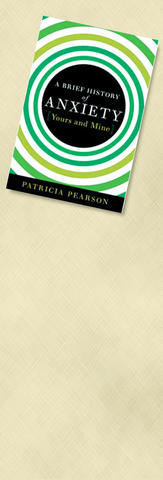For a brief but intense period in 2006, Patricia Pearson logged on daily to Flu Wiki. This is a Web site (fluwikie.com) devoted to the concerns - the very deep concerns - of people convinced that a worldwide outbreak of influenza is imminent, and that it will make the ravages of the Black Death seem like a mildly unpleasant interlude.
"Here could be found a great milling together of fiercely articulate and freaked-out people from around the world, posting to discussion topics like 'What Will We Do With the Bodies?' Pearson writes in A Brief History of Anxiety. Visitors to the site offered suggestions on how to turn back the infected, zombie-like hordes who, in a desperate search for food, will try to invade the fortified homes of the healthy.
Pearson, the author of the highly amusing Area Woman Blows Gasket, sees the humor in Flu Wiki, but she too worries about pandemics. A lot. She also obsesses about sudden liver failure, possibly cancerous moles, flying insects, the supervolcano underneath Yosemite National Park and the possibility that her car will blow up. All of this seems potentially hilarious, but the humor quickly freezes as Pearson describes a lifetime of absurd but crippling fears.

Like 40 million Americans, Pearson suffers from anxiety, which she pithily calls "fear in search of a cause." Her own case fascinates her, and quite rightly. It presents her with the opportunity to examine modern civilization and its discontents, as well as her own miseries, which she does, thoughtfully and incisively.
Her subject is elusive. Unnamed until Freud coined the term "anxiety neurosis," the uninvited stranger lurks at the margins of history. When King David, in the Bible, says that "fearfulness and trembling are come upon me," is he suffering an anxiety attack? Pearson cites an 18th-century English treatise blaming city living for "a class and set of distempers, with atrocious and frightful symptoms, scarce known to our Ancestors," that is, "nervous disorders" afflicting a third of the population. Could this be it?
Everywhere and nowhere, anxiety, Pearson writes, is "unbearably vivid yet insanely abstract." In many cases it is the fear of fear itself, a free-floating, nebulous entity that, like a mutant virus, feeds on any available host. Reason is powerless against it. Pearson argues, in fact, that rationalism, intended to banish superstition and fear, has instead removed one of the most effective weapons against anxiety, namely religious faith and ritual.
Even worse, the worship of reason and science, by encouraging the notion that human beings can control their environment, has created a terrible fault line in the modern psyche, although not all societies suffer equally. Mexicans have lots to worry about but don't. The World Mental Health Survey, conducted in 2002, found that only 6.6 percent of Mexicans had ever experienced a major episode of anxiety or depression. Meanwhile, to their north, 28.8 percent of the American population has been afflicted with anxiety, the highest level in the world. Mexicans who move to the US adapt, becoming more anxious.
In searching for the roots of her affliction, Pearson finds a common thread connecting her traumas and her phobias, the fear of losing control, of being unable to cope. As a child, caught up in the India-Pakistan war in 1971, she cowered in her family's house in New Delhi, waiting for bombs to fall. She was terrified of the dark. At 23, she suffered a nervous breakdown after her boyfriend casually informed her, on a visit to her family's summer house in Canada, that he was seeing another woman. A diagnosis of "generalized anxiety disorder" ensued.
Pearson never finds satisfactory answers to her self-interro-
gations, but the professionals do not do much better. The angriest pages in her book are devoted to the psychiatrists who put her on a regimen of anti-anxiety medications, which dulled the static in her brain but left her "in an emotional half-light," secure but disengaged.
"I'd watch movies without being stirred by them, listen to music without real interest," she writes. "In truth, I began to feel faintly sociopathic." She became addicted to Effexor, and late in the book drops the small bombshell that, as she writes, she has been off an antidepressant called Lexapro for only six weeks.
Pearson married and had children. She has a successful writing career. But the woman she describes can barely hold her life together. One night she dreams that she is lying on a cushioned bench admiring the Grand Canyon. Suddenly she realizes that the bench is attached at one end to a cliff face but is otherwise suspended in midair.
"If I moved even an inch in any direction, I would fall for miles," she writes. "The choking panic that I felt was extraordinary. I felt a perfect - a Platonic - sense of terror."
That, in a nutshell, is her situation, one that she addresses through therapy, pull-up-your-socks willpower and a blend of religion and the insights of writers like the cultural geographer Yi-Fu Tuan. It all seems touch and go - but give her major points for wit and flair. The author biography on the dust jacket reads: "She lives in Toronto with her husband, her two children and her dread."

No one saw it coming. Everyone — including the Chinese Nationalist Party (KMT) — expected at least some of the recall campaigns against 24 of its lawmakers and Hsinchu Mayor Ann Kao (高虹安) to succeed. Underground gamblers reportedly expected between five and eight lawmakers to lose their jobs. All of this analysis made sense, but contained a fatal flaw. The record of the recall campaigns, the collapse of the KMT-led recalls, and polling data all pointed to enthusiastic high turnout in support of the recall campaigns, and that those against the recalls were unenthusiastic and far less likely to vote. That

Behind a car repair business on a nondescript Thai street are the cherished pets of a rising TikTok animal influencer: two lions and a 200-kilogram lion-tiger hybrid called “Big George.” Lion ownership is legal in Thailand, and Tharnuwarht Plengkemratch is an enthusiastic advocate, posting updates on his feline companions to nearly three million followers. “They’re playful and affectionate, just like dogs or cats,” he said from inside their cage complex at his home in the northern city of Chiang Mai. Thailand’s captive lion population has exploded in recent years, with nearly 500 registered in zoos, breeding farms, petting cafes and homes. Experts warn the

A couple of weeks ago the parties aligned with the People’s Republic of China (PRC), the Chinese Nationalist Party (KMT) and the Taiwan People’s Party (TPP), voted in the legislature to eliminate the subsidy that enables Taiwan Power Co (Taipower) to keep up with its burgeoning debt, and instead pay for universal cash handouts worth NT$10,000. The subsidy would have been NT$100 billion, while the cash handout had a budget of NT$235 billion. The bill mandates that the cash payments must be completed by Oct. 31 of this year. The changes were part of the overall NT$545 billion budget approved

The unexpected collapse of the recall campaigns is being viewed through many lenses, most of them skewed and self-absorbed. The international media unsurprisingly focuses on what they perceive as the message that Taiwanese voters were sending in the failure of the mass recall, especially to China, the US and to friendly Western nations. This made some sense prior to early last month. One of the main arguments used by recall campaigners for recalling Chinese Nationalist Party (KMT) lawmakers was that they were too pro-China, and by extension not to be trusted with defending the nation. Also by extension, that argument could be